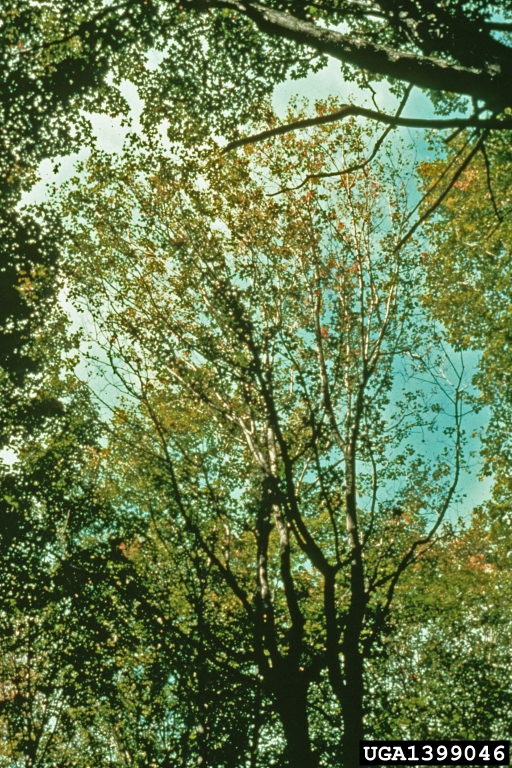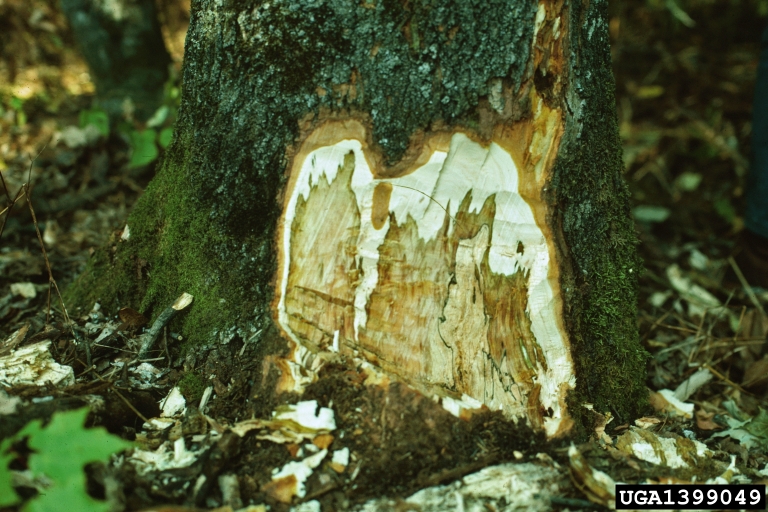Endoconidiophora Coerulescens on:
[Wikipedia]
[Google]
[Amazon]
''Ceratocystis coerulescens'' is an ascomycete fungus and the causal agent of sapstreak disease in sugar maple trees. There is debate about whether it is one species or two; the second being ''Ceratocystis virescens.'' For simplicity, this page will refer to this pathogen as one species. It is also known by its anamorph name ''Endoconidiophora virescens.''


USDA ARS Fungal Database
{{Taxonbar, from=Q5063765 Fungal plant pathogens and diseases Microascales Fungi described in 1950 Fungus species

Host and symptoms
This fungus is often found as a saprophyte on logs of woody species. It causes sapstreak disease in just one host species: ''Acer saccharum
''Acer saccharum'', the sugar maple, is a species of flowering plant in the soapberry and lychee family Sapindaceae. It is native to the hardwood forests of eastern Canada and the eastern United States. Sugar maple is best known for being the p ...
'', commonly known as the sugar maple or rock maple. Symptoms include a sparse crown, dieback, dwarfed leaves, and cankers. Infected trees may die suddenly or languish for 2–4 years. The symptom most characteristic of sapstreak disease is yellowish-green stained wood that is also very moist. Once the wood is cut and dries, the stains turn light brown, so they're difficult to see and diagnose at that point.
Disease cycle
As an ascomycete, ''Ceratocystis coerulescens'' produces ascospores encased as groups of eight in asci. The asci are protected by a perithecium, a flask-shapedascocarp
An ascocarp, or ascoma (: ascomata), is the fruiting body ( sporocarp) of an ascomycete phylum fungus. It consists of very tightly interwoven hyphae and millions of embedded asci, each of which typically contains four to eight ascospores. Ascoc ...
, in which the pathogen overwinters. Ascospores are the sexual spores and are far less common than the asexual spores known as conidia. The conidia form on conidiophores without a sporocarp. ''C. coerulescens'' has two mating types referred to as Mat-1 and Mat-2, but it is not a strictly heterothallic species. The Mat-1 type is self-sterile and must cross with Mat-2 to produce perithecia. However, the Mat-2 type is self-fertile and half of the progeny from a Mat-2 selfing are Mat-1.
Environment
Sapstreak disease has occurred only in North America and primarily insugar bush Sugar Bush may refer to:
* Sugar bush, a forest that is harvested for maple syrup.
Plants
* Sugar Bush (''Rhus ovata''), an evergreen shrub that grows in the southwest United States
* Common Sugarbush Protea (''Protea repens'')
* ''Protea'', a g ...

Pathogenesis
''Ceratocystis coerulescens'' enters its host through wounds, especially wounds in buttress roots and lower trunk. All diseased trees have been found to have man-made wounds from tapping and/or driving and dragging logs over them. Therefore, it's believed that the trees successfully combat the pathogen when it enters wounds higher up made by animals, insects, or weather. Sapstreak disease is commonly associated with the presence of opportunistic fungi ''Armillaria
''Armillaria'' is a genus of fungi that includes the '' A. mellea'' species ('honey fungus') that live on trees and woody shrubs. It includes about 10 species formerly categorized summarily as ''A. mellea''. ''Armillaria'' sp. are long-live ...
'' and/or ''Xylaria
''Xylaria'' is a genus of ascomycetous fungi commonly found growing on dead wood. The name comes from the Greek ''xýlon'' meaning ''wood'' (see xylem).
'Outline of Fungi and fungus-like taxa' by Wijayawardene et al. lists up to (ca. 571) spe ...
''.
Importance
Sapstreak threatens maple syrup production primarily, but also ruins the wood for making lumber. The economic and environmental damage due to this pathogen is currently meager. Most instances have occurred after incautious logging and have been well contained. Usually a single tree or a small group is affected.Management
The best way to manage this disease is to prevent it by avoiding injuries to the roots and lower stems of sugar maples. This can be accomplished by using the same, well-placed trails every year through the sugar bush and by using tubing systems instead of buckets to collect sap. When infection does occur, the tree should be cut down and the wood promptly removed to reduce inoculum.References
External links
USDA ARS Fungal Database
{{Taxonbar, from=Q5063765 Fungal plant pathogens and diseases Microascales Fungi described in 1950 Fungus species